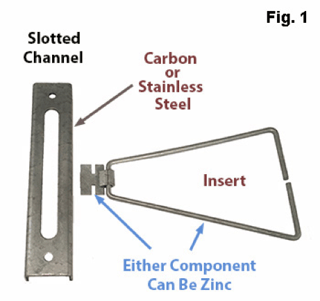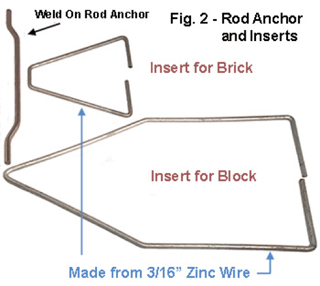Masonry Anchors to a steel fabricator commonly mean Slotted Channel or Rod Anchor. Note: Slotted Channel is sometimes known as a Gripstay® Anchor or Channel Slot Anchor. Rod Anchor, is sometimes known as a Wire Tie, or a Weld-On Wire Tie. These are the two most prevalent systems for securing Block or Brick to structural steel.
 While the majority of Slotted Channel and Rod Anchor systems are carbon steel, the fabricator will occasionally see requirements for Zinc in the connection. This is usually the case with firewalls and is done because of the low melting point zinc offers. In a fire, the zinc masonry anchor will melt leaving the wall disconnected from the steel structure.
While the majority of Slotted Channel and Rod Anchor systems are carbon steel, the fabricator will occasionally see requirements for Zinc in the connection. This is usually the case with firewalls and is done because of the low melting point zinc offers. In a fire, the zinc masonry anchor will melt leaving the wall disconnected from the steel structure.
A common misconception with these designs is that once separated, the wall will then collapse. The actual purpose is for the Firewall to remain standing if the structure weakens or collapses. Carbon Steel, the type used to roll I-Beams, has a melting point of 2,600° to 2,800°F, But its strength begins to deteriorate at 1,100°F. Building fires often reach this temperature and as the steel weakens it can bend, flex, or twist, and the structure becomes compromised. As it collapses, it will pull the wall down and an important protection that keeps the fire contained is lost.
By making the Masonry Anchors from zinc, the melting point of those components drops to 787°F. Remember, that’s melting point. By the time the ambient temperature reaches 800°F, and before the steel weakens, the zinc is liquid and the connection no longer exists.
 The typical Zinc Fire Wall Masonry Anchor system a Steel Fabricator will encounter will have a carbon or stainless-steel weld-on anchor and a zinc insert. As shown in Fig. 1 either piece of the insert can be zinc. As soon as that component goes above 787°F, it will become liquid and the connection is broken. In the case of a Rod Anchor, or Weld-On Wire Tie, the Insert will be one piece zinc wire with the same result. (Fig. 2)
The typical Zinc Fire Wall Masonry Anchor system a Steel Fabricator will encounter will have a carbon or stainless-steel weld-on anchor and a zinc insert. As shown in Fig. 1 either piece of the insert can be zinc. As soon as that component goes above 787°F, it will become liquid and the connection is broken. In the case of a Rod Anchor, or Weld-On Wire Tie, the Insert will be one piece zinc wire with the same result. (Fig. 2)
Standard carbon steel and stainless steel Slotted Channel and Rod Anchors are regular stock items and frequently ship the day they are ordered. Due to their infrequent use and irregular designs, Zinc inserts tend to be made to order. For this reason, it is recommended that the fabricator allow extra time for production and shipment.





